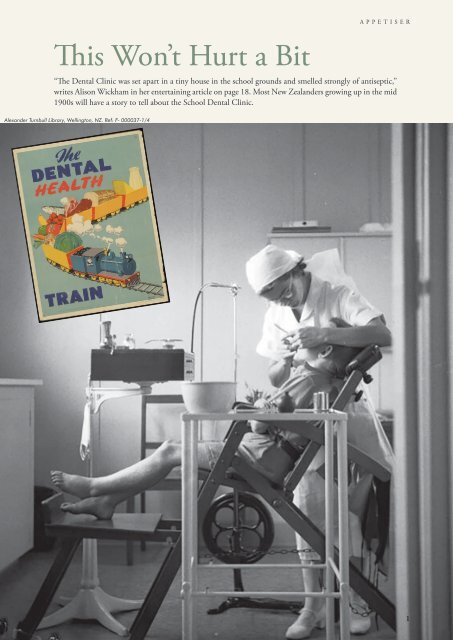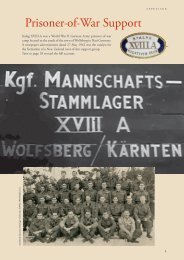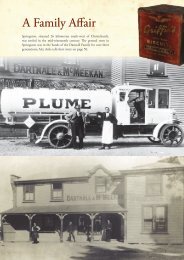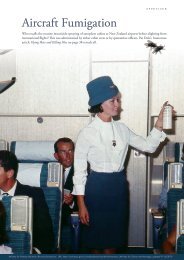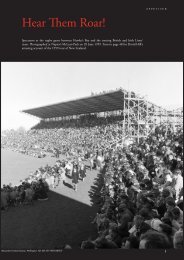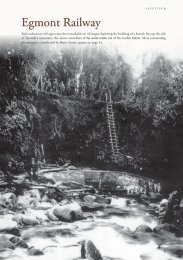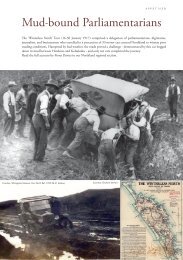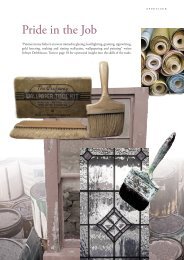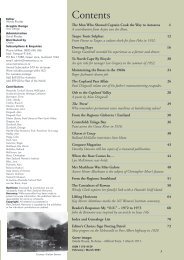You also want an ePaper? Increase the reach of your titles
YUMPU automatically turns print PDFs into web optimized ePapers that Google loves.
APPETISER<br />
This Won’t Hurt a Bit<br />
“The Dental Clinic was set apart in a tiny house in the school grounds and smelled strongly of antiseptic,”<br />
writes Alison Wickham in her entertaining article on page 18. Most <strong>New</strong> <strong>Zealand</strong>ers growing up in the mid<br />
1900s will have a story to tell about the School Dental Clinic.<br />
Alexander Turnbull Library, Wellington, NZ. Ref: F- 000037-1/4<br />
1
EDITORIAL<br />
Dear Readers,<br />
The plus of being in lockdown is the lack of distractions. Not that I would like to be<br />
isolated from society for too long, but it certainly has enabled me to prepare future<br />
magazines well ahead of time. Thankfully, history never dates. As I pen this letter, I<br />
am grateful to live in a country which has taken a wise approach to the pandemic,<br />
and grateful to a people who have respected the need for these periods of temporary<br />
isolation.<br />
No such difficulties for Alwyn Owen in 1936 when the family invested in their<br />
new radio, a mantle set, “joining the 182,500 other <strong>New</strong> <strong>Zealand</strong>ers who already<br />
held licences”. The licence fee was twenty-five shillings, not to be sneezed at in<br />
those depression years… and then there was installation costs. Alwyn’s familybased<br />
stories are always a treat and his account of That Radio will prompt an enthusiastic response.<br />
Ian Dougherty, another acclaimed writer, returns with the story of Arawata Bill. Not a fictional folklore legend,<br />
but a real identity whose character is brought to life in Ian’s fine article with the rugged South’s gold mining<br />
landscape as a backdrop.<br />
I did laugh at Gordon Tait’s exacting remarks relating to his job at Wellington’s Government Print; so typical<br />
of governmental departments in the mid twentieth century. “Bundles of letters were tied up in green tape,<br />
but important bundles were tied in red tape.” “Stationery was closely guarded and given out sparingly”. Many<br />
readers will be nodding their heads at this point. Another ‘who remembers’ story, and a tell-tale sign of age, is<br />
Alison Wickham’s account of Fun and Games Between Lessons and playground memories of playing swaps, the<br />
ball game ‘Four-square’, skipping to unforgettable rhymes - Bluebells, Cockle Shells, Eevie Ivy Over – marbles<br />
and knucklebones. Add on your own list.<br />
As an Aucklander, the appeal of sitting on a horse tramway rather than in a motorway queue has a romantic<br />
appeal. The story of Devonport’s tramway is documented by Derek Whaley and takes readers back to the<br />
nineteenth century when the traffic jams of today would have been unimaginable.<br />
Before I sign off I would like to acknowledge a man of many talents, Max Cryer, who passed away on 26<br />
August. We were privileged to publish his contributions, the last a Christmas-themed story in our 25th<br />
Anniversary edition last December<br />
May the joys of Spring not be hampered by lengthy restrictions.<br />
Wendy Rhodes,<br />
Editor<br />
For just $79 you receive an annual<br />
subscription to <strong>New</strong> <strong>Zealand</strong> <strong>Memories</strong>.<br />
Six superb issues direct to your letterbox.<br />
A G i f t o f D i s t i n c t i o n<br />
Surprise a friend or relative with a gift subscription.<br />
We will even gift wrap the first issue, include a gift<br />
card with your personal message and post it direct.<br />
Freephone: 0800 696 366 or<br />
Freepost: 91641<br />
PO Box 17288<br />
Green Lane, Auckland 1546<br />
Email: admin@memories.co.nz<br />
Subscribe and Save!<br />
Visit our website w w w.memories.co.nz for subscriptions and gift ideas.<br />
Order online securely today and pay via internet banking or credit card.<br />
2
Editor<br />
Wendy Rhodes<br />
Graphic Design<br />
Icon Design<br />
Administration<br />
David Rhodes<br />
Distributed by<br />
Ovato<br />
Subscriptions & Enquiries<br />
Phone tollfree: 0800 696 366<br />
Mail: Freepost 91641,<br />
PO Box 17288, Greenlane, Auckland 1546<br />
email: admin@memories.co.nz<br />
www.memories.co.nz<br />
Annual Subscription $79 for six issues<br />
(Price includes postage within NZ)<br />
Contributors<br />
Alexander Turnbull Library, Wellington, NZ<br />
Archives <strong>New</strong> <strong>Zealand</strong><br />
Te Rua Mahara O Te Kawanatanga<br />
Auckland City Libraries<br />
Carr, Clare<br />
Central Hawke’s Bay Museum<br />
Cowan, Bill<br />
de Vries, Clark<br />
Dougherty, Ian<br />
Gore, Kate<br />
Hill, David<br />
McCarthy, Pat<br />
Moore, Anne<br />
Otago Girls’ High School<br />
Owen, Alwyn<br />
Russell Museum<br />
Smallfield, Jane<br />
Sneddon, M<br />
Speden, Gordon<br />
Stewart, Graham<br />
Sullivan, Jim<br />
Tait, Gordon<br />
Tarawhiti Museum<br />
Te Whare Taonga O Te Tairawhiti<br />
Thompson, Robert<br />
Toitu, Otago Settlers Museum<br />
Trask, Peter<br />
Tucker, Gary<br />
Whaley, Derek. R.<br />
Wickham, Alison<br />
Contents<br />
That Radio 4<br />
“It wasn’t until 1936 that we bought our first radio,”<br />
writes Alwyn Owen.<br />
The Lost Horse Tramway of Devonport 8<br />
Contributed by Derek R. Whaley, Auckland Libraries.<br />
Mixed Train to Oamaru, 1955 16<br />
Bill Cowan relates a railway story from the 1950s.<br />
Fun and Games Between Lessons 18<br />
Alison Wickham recalls Palmerston North schooldays.<br />
From the Regions: Otago 26<br />
Centrefold: The Anglers’ Eldorado 36<br />
Mako shark caught by Bob Kennett on 21 January 1961.<br />
Arawata Bill 38<br />
Ian Dougherty writes an account of the legendary gold prospector.<br />
Government Service 44<br />
Gordon Tait was a public servant in the 1970s.<br />
The Kitchen Stove in the 1920s 50<br />
The hub of Anne Moore’s home.<br />
Food For Thought 51<br />
Different era… different meaning.<br />
From <strong>New</strong> <strong>Zealand</strong> to England by Ship, 1952 52<br />
Pat McCarthy boarded the m.v. Rangitoto for the five-week voyage.<br />
From the Regions: Hawke’s Bay 58<br />
Mailbox 68<br />
Index and Genealogy List 70<br />
Editor’s Choice: Shipboard Boxing 72<br />
Seaman from the HMNZS Archilles entertain the crew.<br />
Opinions: Expressed by contributors are not<br />
necessarily those of <strong>New</strong> <strong>Zealand</strong> <strong>Memories</strong>.<br />
Accuracy: While every effort has been made to<br />
present accurate information, the publishers take no<br />
responsibility for errors or omissions.<br />
Copyright: All material as presented in<br />
<strong>New</strong> <strong>Zealand</strong> <strong>Memories</strong> is copyright to the publishers<br />
or the individual contributors as credited.<br />
ISSN 1173-4159<br />
October/ November 2021<br />
Cover image:<br />
D. Annand Bookseller & Stationer,<br />
Waipawa in the early 1900s..<br />
Courtesy: Central Hawke’s Bay Museum collection.<br />
3
STORY<br />
That Radio<br />
Alwyn Owen<br />
N.Z. Vintage Radio Society<br />
It wasn’t until 1936 that we bought our first radio. The neighbours on one side had one, our friends the<br />
Hirons in Second Avenue had two – one in the kitchen and one in the ‘front room’- and Bob Worner, who<br />
lived in a beautifully-converted railway carriage next door to the Hirons, had a magnificent free-standing<br />
one, gloriously encased and half the size of a piano, with eight valves tucked away inside it.<br />
And we didn’t have a radio.<br />
Dad tried to tell his two whining youngsters that we were saving every penny to get out of our rented house<br />
and into a home of our own, that we had no spare cash for anything as frivolous as a radio. But then, in late<br />
1935, his resolve weakened as the prospect of political and social change faced the country, and a radio became<br />
not a luxury, but a seeming necessity. Even so, it wasn’t until February the following year that we finally joined<br />
the 182,500 other <strong>New</strong> <strong>Zealand</strong>ers who already held licences ‘to operate a radio receiving station’ and bought<br />
a radio ourselves.<br />
It arrived in a wooden box, snugly cushioned in pages of the Northern Advocate, and once it had been unpacked,<br />
Huw and I demanded that it be plugged in and switched on, but Dad refused to do so. A radio wasn’t like a<br />
toaster or an electric jug, he explained, it had to be ‘installed’, and that was quite a process, but Herbie Aldred<br />
(who lived just a few doors away and knew a bit about radio) would help us to set it all up in the weekend. Dad<br />
didn’t mention that the radio dealer could have set it up immediately, but that would have been an additional<br />
cost to the twelve quid or so paid for the set, and on top of that, there was still thirty bob to be found for the<br />
licence fee. So we’d wait, until Herbie was free the next Saturday and Dad had collected the few necessary bits<br />
and pieces that Herbie had set down on a list for him.<br />
4
STORY<br />
N.Z. Vintage Radio Society<br />
“A radio wasn’t like a<br />
toaster or an electric jug,<br />
he explained, it had to<br />
be ‘installed’...”<br />
Meanwhile the radio sat, mute and modest, on a shelf in our kitchen-cumlivingroom.<br />
For modest it undoubtedly was – a basic five-valve mantle set made by Radio<br />
Ltd., and in our case, distributed by Bond and Bond under their house-brand<br />
Skyscraper. Radios were then classed as either ‘mantle’ or ‘console’, the latter<br />
being free-standing, and oh Lord, how magnificent some of them were, with<br />
their beautiful inlays and rich grain, polished so that you could look right down<br />
into the soul of the wood, like the back of a fine violin. Come to that, some of<br />
the mantle sets were not too bad either in that respect either, but not ours – ours<br />
was a plain box, relieved only by fretwork covering the speaker grille, with a small<br />
escutcheon on either side, the left-hand one bearing the word ‘Volume’, and its<br />
neighbour showing in its recess what appeared to be black numerals against a<br />
murky grey-brown background. No ’tone control’, no flash ‘airplane dial’ with<br />
all stations identified, no ‘short wave’, and of course like all radios of its era, no<br />
FM... But make no mistake, for all its lack of glamour it was a perfectly efficient<br />
work-horse of a radio.<br />
As it turned out, “installation” proved not too difficult a job. We put up the<br />
aerial first, a horizontal wire that ran between a manuka pole at one end and<br />
our convenient cabbage tree at the other, and electrically isolated from them by<br />
ceramic ‘egg insulators’ that were strung in a series of three at each end of the<br />
aerial. A vertical wire was attached near one end of the horizontal portion to form<br />
an inverted ‘L’ (which indeed was the technical term for this type of aerial) and<br />
this, the ‘downlead’ would ultimately be connected to the radio.<br />
Two holes were then drilled through the wall of the house below the radio shelf,<br />
the uppermost one providing a snug fit for the ‘lead-in tube’ – an ebonite tube<br />
containing a threaded brass rod with a wing-nut at each end; this carried the<br />
signal from the down-lead to the interior of the house, where the red aerial lead<br />
dangling from the radio was attached to it. The radio’s black ‘earth’ lead was then<br />
extended, poked through the second hole, and attached to a three-foot length of<br />
metal pipe that Herbie had driven into the earth for nearly its full length – a good<br />
‘earth’, he explained, was as necessary as a good aerial.<br />
Last of all, a ceramic ‘lightning arrestor’ was screwed on to the external wall<br />
of the house and connected between the aerial and earth. It contained nothing<br />
more than a couple of wires with a gap between them, all sealed with pitch, the<br />
idea being that any lightning strike on the aerial would jump the gap and dissipate<br />
harmlessly in the earth instead of blowing the radio sky-high – without an arrestor<br />
any insurance claim on the radio, and possibly the house, would be dismissed in<br />
the event of a lightning strike.<br />
So it was all done. The licence fee had been paid (it had been reduced to twentyfive<br />
shillings since 1934 we discovered) and with our radio now installed, we all<br />
trooped inside for the ceremonial switch-on.<br />
One thing I remember vividly: at the moment we switched the radio on, that<br />
murky brown tuning dial sprang into gorgeous life in a wonderful rich amber<br />
glow that set its black numerals in high contrast. To my nine-year-old mind, that<br />
was magic; that was the miracle, not the sound that came a couple of seconds later<br />
as the valves warmed up. I’m convinced that that first sight of a back-lit tuning<br />
dial was the trigger that led me to begin building my own radios within a few<br />
years, and later, to a career in the medium.<br />
Well, we now had our radio, but in hindsight we should have bought it three<br />
months earlier, when we’d have been able to hear the run-up to the 1935 General<br />
Election and the extraordinary event that occurred in Auckland preceding it, as<br />
radio and politics became entangled.<br />
5
STORY<br />
Auckland’s favourite radio station by far was<br />
‘Friendly Road’ 1ZB, run by Colin Scrimgeour<br />
and Tom Garland. As previous Methodist city<br />
missioner, ‘Scrim’ or ‘Uncle Scrim’ had well known<br />
the misery of Auckland’s poor and unemployed, and<br />
with his compassion, keen sense of social justice and<br />
outstanding communication skills he’d become a<br />
leading figure during Auckland’s Depression years.<br />
He was also innovative, opportunistic and far from<br />
unworldly, and in 1934 he’d bought Station 1ZB for<br />
fifty pounds (after selling his wife’s piano to pay for it)<br />
and the station had gone from strength to strength;<br />
his weekly Sunday night talk, ‘The Man in the Street’<br />
in particular had become almost obligatory listening.<br />
Now, an election, postponed the previous year,<br />
was looming. The reigning Coates / Forbes coalition<br />
of the Reform and United Parties was seen by many<br />
as uncaring and mean-spirited in its policy of tight<br />
financial restraint, but then the contending Labour<br />
Party… good heavens, could a gang of union rabblerousers<br />
and ex-jail-birds be trusted to run the country?<br />
The run-up to the poll was tense, and rumour spread<br />
that during his ‘Man in the Street’ broadcast on the<br />
Sunday evening before the election, Scrim would<br />
openly solicit a Labour vote.<br />
It seems that the then- postmaster-general Adam<br />
Hamilton panicked, and suggested to his P and T<br />
Department (but not in writing of course) that it<br />
might be advisable that the broadcast not proceed.<br />
Perhaps it could be ‘jammed’?<br />
It was, and all hell broke loose. The Government<br />
denied all responsibility, but evidence was quickly<br />
found that the P and T Department had been directly<br />
involved, though nothing could be sheeted home to<br />
its Minister and ultimate responsibility was never<br />
completely uncovered. In the backlash, Scrim was<br />
permitted to re-broadcast his original script a night<br />
later without interference, and it contained no<br />
endorsement of the Labour Party.<br />
But the damage had already been done, and in<br />
Auckland at least, the incident had done nothing to<br />
further the Coalition’s chances. The following Saturday<br />
Labour was elected in a landslide victory.<br />
All this we might have heard, but in putting the<br />
clues together in later years, I realised Dad’s interest<br />
lay not so much in the election result itself – which<br />
he regarded as a foregone conclusion anyway – as<br />
in the social changes Labour had promised, and<br />
these, already hinted at, would be outlined in the<br />
Speech from the Throne when the new Government<br />
took office. Furthermore, the occasion would be<br />
broadcast, and for the first time in the Western world,<br />
parliamentary proceedings (and later, debates) would<br />
be thrown open to all who might listen…and that was<br />
why Dad had deferred the purchase of his radio.<br />
Similar latecomers were offered an even cheaper<br />
option than our little Skyscraper. In a wild burst of<br />
enthusiasm that must surely have placed passion<br />
above profit, one manufacturer produced a radio that<br />
was not only named Parliamentary, but also carried a<br />
picture of Parliament House placed persuasively above<br />
its volume control.<br />
But now, and scarcely four months after the Election,<br />
everything, was ready, and on the 25th of March 1936<br />
the four YA stations linked to broadcast the election of<br />
the Speaker, and next day, the Speech from the Throne –<br />
and It all went splendidly. However the Government’s<br />
desire to ‘bring Parliament to the People’ was more<br />
than a simple display of democratic fervour; it was<br />
also a counter to what Labour perceived as a largely<br />
hostile Press, and when it came to the parliamentary<br />
debates broadcast in later months, both context and<br />
speakers were carefully selected and speeches limited<br />
in duration, to better present Government views.<br />
If my father had expected the full cut-and-thrust<br />
of political debate, unabridged and free from any<br />
editorial filtering, he must have felt he wasn’t quite<br />
getting his money’s worth from the radio he’d bought.<br />
And he wasn’t the only one; a correspondent to the<br />
Auckland Star wrote:<br />
Alexander Turnbull Library, Wellington, <strong>New</strong> <strong>Zealand</strong>. Ref: A-312-1-191. Blomfield, William<br />
“Auckland’s favourite radio station<br />
by far was ‘Friendly Road’ 1ZB,<br />
run by Colin Scrimgeour and Tom<br />
Garland.”<br />
Labour Prime Minister Michael Joseph Savage<br />
photographed with Colin Scrimgeour in 1938.<br />
Auckland Weekly <strong>New</strong>s August 17, 1938.<br />
6
STORY<br />
…The so-called debates do not by any means represent what<br />
takes place in Parliament “off air”…Wireless is supposed to<br />
be for the amusement, entertainment and education of the<br />
public. The Parliamentary debates are fraudulent; they do not<br />
represent Parliament – they are not amusing or educational.<br />
They are just political bluff. On both sides of the House.<br />
But after a few years, and a renewed mandate for the<br />
Government in 1938, things became a little more relaxed. A<br />
new 2YA transmitter had come on stream, meaning that the<br />
old one, now 2YC, could take over Parliamentary broadcasts<br />
and the YA stations could resume their normal stodgy fare of<br />
worthy evening talks and daytime doses of Gracie Fields and<br />
Peter Dawson. The broadcasting of Parliament was becoming<br />
just another facet of <strong>New</strong> <strong>Zealand</strong> life.<br />
Writing to the Nelson Evening Mail in September of 1938,<br />
one poetically-minded citizen put it this way:<br />
Prime Minister Michael Savage and the Director of the<br />
National Broadcasting Service, James Shelley, are depicted in<br />
this Blomfield cartoon published in the <strong>New</strong> <strong>Zealand</strong> Observor<br />
on 4 February 1937.The caption reads, “Castles in the Air.<br />
The Government proposes to establish in Wellington a great<br />
broadcasting and cultural centre - to be built from the licence<br />
fees of listeners.<br />
At times heated discussions stir the public interest,<br />
They occasionally make reference to the ape,<br />
And the public quickly visualise how far we have advanced<br />
When listening to political debate.<br />
The home life of <strong>New</strong> <strong>Zealand</strong> has changed beyond all dreams<br />
The children with their elders arbitrate.<br />
Mickey Mouse and fairy yarns are no longer bed-time talk,<br />
Children argue on Political Debate.<br />
Everyone has a wireless, and the girls are getting scared<br />
Courting will be controlled by the State.<br />
Instead of taking Emma for a cuddle and a spoon,<br />
Bill listens to Political Debate<br />
We have listened to dictators, prime ministers and kings,<br />
Inspiration from their speeches we can take.<br />
But in seeking inspiration, there are times when we perspire<br />
When listening to Political Debate.<br />
N.Z. Vintage Radio Society<br />
But for good or ill Parliamentary broadcasting was now an<br />
established fact of life that we had learned to accept, and by<br />
1938 Dad had relaxed a little in his listening (to Mum’s relief<br />
I suspect), and wasn’t above forsaking Parliament to follow<br />
the fortunes of Dad and Dave. By that time too, we had just<br />
moved into a house of our own, and of course the Skyscraper<br />
came with us, and having once been through the drill we had<br />
no hesitation in “installing” it ourselves, hitching our aerial<br />
up to a convenient tree (macrocarpa, this time), connecting<br />
our ground wire and so on. And for the next few years<br />
that modest little radio continued to serve us faithfully and<br />
well…until circumstances compelled us to buy something<br />
rather more sophisticated, with six valves, and short-wave.<br />
The world had lost its senses – again - and World War II<br />
had erupted. n<br />
7
REGIONS<br />
Otago Girls’ High School – Celebrating 150 Years<br />
Jane Smallfield<br />
Archivist, Otago Girls’ High School<br />
Otago<br />
First day pupils on 6 February 1871. Of note is the fence to keep boys from Otago Boys’ High School out.<br />
On the 6 February 1871, the first state girls’ high school in the Southern Hemisphere opened in Dowling<br />
Street (now Tennyson Street), Dunedin. Originally known as the Provincial School for Girls, it soon became<br />
known as Otago Girls’ High School. This year the school celebrates its 150th Jubilee with the main celebration<br />
taking place at Labour Weekend, having been postponed from Waitangi Weekend due to Covid.<br />
The founder of the school was a remarkable woman by the name of Miss Learmonth Whyte Dalrymple who<br />
was born in Couper Angus, Scotland. Miss Dalrymple immigrated to <strong>New</strong> <strong>Zealand</strong> with her father and siblings<br />
in 1853, and after time spend in the Clutha area she moved to Dunedin.<br />
When the Otago Boys High School opened in 1863, Dalrymple began to wage a persistent seven-year long<br />
campaign for girls’ secondary education in Otago. She started by connecting with those who would help her<br />
achieve her goal. Her first ally was the Otago Daily Times, which published a “leader” in August 1863, around<br />
the time Boys’ High was opened, suggesting that there should be an equivalent school for girls. There was little<br />
interest from the readership however, with only one letter of support in reply.<br />
30
OTAGO<br />
“Miss Dalrymple had a<br />
dream; she was inspired<br />
and inspired others to fight<br />
for the right of girls and<br />
women to be educated.”<br />
Miss Learmonth Whyte Dalrymple<br />
Miss Dalrymple had a battle on her hands, it was generally considered that girls were not equipped either<br />
mentally or physically for intensive studies. The place of woman was the home, her task to care for her husband’s<br />
physical needs, and to produce and raise a family, and what husband wanted a wife more knowledgeable than<br />
himself? But Miss Dalrymple was not deterred and along with the support of Major John L C Richardson, a<br />
member of the Provincial Council, a petition was circulated to get the support of the community. However, it<br />
was not just men who thought there was no need to education girls, many women considered a public school<br />
for girls ‘intolerable’; others said the schools were good enough already; that girls would be worse off for being<br />
learned; and that the idea was ahead of its time. Many women felt positively scared to sign the petition.<br />
Over the next two years Miss Dalrymple continued to write letters, collect information, and keep the matter<br />
before the Provincial Council and the public. Miss Dalrymple also spoke to Mr Macandrew who was then the<br />
Superintendent of the Provincial Council. So persuasive was she that Macandrew instructed the Secretary of the<br />
Education Board to come up with a proposal which was presented to the Provincial Council in 1868. Progress<br />
was beginning to happen.<br />
On 9 June 1870 Mrs Margaret Burn was appointed to the role of Lady Principal of the new girls’ high school.<br />
Born in Edinburgh, and later settling in Australia, Mrs Burn later opened a private school in Geelong and it was<br />
her success in this work that led to her appointment at Otago Girls’.<br />
31
CENTREFOLD<br />
Bob Kennett and friends with their 103lb Mako shark<br />
on 130lb tackle. Bob caught the fish whilst aboard the<br />
Fuller’s game fish launch Miss Helen on 21 January 1961.<br />
Bay of Islands Swordfish Club photographer Ian Hanlon<br />
recorded the occasion.<br />
The Mako is weighed using an old crane that originally sat<br />
at a private jetty and dates from the 1870s. The historic<br />
crane now sits in the grounds of the Russell Museum<br />
and fish are either tagged and released or weighed on a<br />
modern automated weigh station.<br />
Photo Ian Hanlon via Russell Museum Te Whare Taonga o Kororāreka<br />
36
CENTREFOLD<br />
The Anglers’ Eldorado<br />
37
REGIONS<br />
Be It Ever So Humble<br />
David Hill<br />
Napier<br />
There’s only one, faded photo of the house where I lived till I was 15.<br />
There’s only one because it was the years 1942 -1956. Few families had cameras then, and if they did, it was<br />
most likely a clunky little Box Brownie, with a viewfinder you had to squint into while you manoeuvred to keep<br />
your back to the sun.<br />
My parents didn’t have a camera. They didn’t have much of anything. The house was a rented one, and they<br />
were saving every shilling they could towards that golden dream: A Place Of Their Own.<br />
It wasn’t a house worth photographing, anyway, except as a reminder of how far most of us have come. It was<br />
leaky, pokey, dank – but the sort of place families were glad to have in those post- WWII years when homes of<br />
any sort were in such short supply.<br />
It’s over 60 years since I’ve been inside it, though I’ve driven past it numerous times, and watched its exterior<br />
change from shabby to gentrified, then fade to shabby again. But I can still see most of its rooms clearly. Let me<br />
take you on a tour.<br />
It was on Hospital Hill in Napier, a cramped cube built in the 1910s or even earlier. It was probably a snug<br />
little home then, but by the time we lived in it, its snugness had long gone.<br />
Early houses on Hospital Hill were – still are – a mixture of little boxes and big boxes of weatherboard walls<br />
and corrugated-iron roofs. Woolstore workers, wharfies, labourers lived in the little ones; lawyers and managers<br />
of Blythes or McGruers Department Stores in the big ones.<br />
Ours was definitely little. On one side ran a skinny lane. On the other stretched a double frontage with<br />
jacaranda trees and flowering cherries, framing a white-and-grey villa three times the size of our place. It was<br />
owned by a.....a lawyer.<br />
His property included a full-sized tennis court, stretching along behind our back fence. When the first detailed<br />
aerial photos of Napier were taken in the early 1950s, the lawyer’s son told us “Your place looks like part of<br />
ours”. I’m sure my Mum never forgave him.<br />
But it’s our cramped little cottage I want to tell you about. It stood only two metres from Napier Terrace. (We<br />
lived on the side with no footpath; that seemed fitting, somehow.)<br />
There was a sagging, bullnosed front verandah of red corrugated iron that kept the two rooms behind it<br />
permanently dark. A front door that only strangers knocked at.<br />
Inside, an unlit hallway with dark-brown wooden floor, and wallpaper of twining, writhing patterns in dull<br />
green and faded yellow that I suppose were meant to be forest trees or such.<br />
To me, they were snakes. When I was little, I hated and feared our hallway. I was sure the snakes would jerk<br />
to life and seize me. If I had to go down it, I’d either creep along so the snakes wouldn’t hear me, or stamp and<br />
swagger, talking loudly as if there were six of me.<br />
“And here comes that only photo. It’s me, about eight years old,<br />
sitting and reading on the back verandah. The bathroom window<br />
is behind me; the laundry door gapes open.”<br />
60
HAWKE’S BAY<br />
61
INDEX and GENEALOGY LIST<br />
A<br />
A & A.J. Caithness 63<br />
AICKIN Graves 13<br />
ALISON Ewen W. 10<br />
ANNAND D. 3<br />
Anzac Day 20<br />
Aoroa 15<br />
Arawata Bill 39<br />
Arawhata River 39<br />
AraWhata Valley 43<br />
Auckland 10, 44<br />
Auckland Electric<br />
Tramways Co. 15<br />
Auckland Harbour 53<br />
aviation (Mt Cook Co.) 41<br />
AVISON Betty 66<br />
B<br />
baggage allowance (ship) 52<br />
baking (coal range) 50<br />
Bay of Islands Swordfish Club 37<br />
bibby cabin (Rangitoto) 54<br />
Blackhead 28<br />
BLACKMAN Chris 52<br />
Frank 54<br />
Maisie 52<br />
Michael 52<br />
Pat 52<br />
Bott Boot Repairer 67<br />
boxing 72<br />
broadcasting 4<br />
Brothers Lighthouse 68<br />
BUCHANAN Seaman B. 72<br />
BURN Margaret 31<br />
Burton Bros. 67<br />
C<br />
camping 34<br />
Cape Kidnappers 59<br />
CARGILL John 28<br />
William 28<br />
Cargill's Castle 29<br />
CAVE Charles W. 10<br />
Central Otago 39<br />
Cheltenham 11<br />
Cheltenham Beach 11<br />
Cheltenham Cash Store 15<br />
clerical officer 44<br />
coal 50<br />
coal range 50<br />
Commercial Hotel (Waipawa) 66<br />
COWAN Agnes 41<br />
CRAWFORD Mr W.F. 58<br />
CRAWLEY Norrie 65<br />
D<br />
DALRYMPLE Learmonth 30<br />
dental care 1, 23<br />
dental clinic 1, 23<br />
Depression, The 6<br />
Devil's Elbow 58<br />
Devonport 8<br />
Devonport Borough Council 14<br />
Devonport Domain 13<br />
Devonport Steam Ferry Co. 10<br />
Devonprot Waterworks 14<br />
Devonport Road Board 10<br />
Druids 68<br />
DUDER Robert 15<br />
Dunedin 16, 27<br />
Dunedin Hospital 42<br />
Dunedin Town Board 27<br />
E<br />
EDISON Thomas 72<br />
education 18, 30<br />
Elsthorpe 64<br />
Empire Hotel (Waipawa) 67<br />
employment 44<br />
F<br />
Fairbrother & Co. 67<br />
fashion (workplace) 47<br />
FAZAKERLY Elizabeth 27<br />
ferryman 39<br />
Fiordland 40<br />
FISHER Mrs 19<br />
folk hero (Arawata Bill) 42<br />
Forbury 28<br />
Frankton 41<br />
Frankton Aerodrome 41<br />
Frenchman's gold 39<br />
Friendly Road radio 6<br />
G<br />
GARLAND Tom 6<br />
General Election (1935) 5<br />
Glendhu Bay 34<br />
GLOVER Denis 42<br />
GODBER Albert 26<br />
gold mining 39<br />
gold prospecting 40<br />
government attire 47<br />
Government Print 44<br />
government service 44<br />
government stationery 47<br />
grading system (govt) 49<br />
GREANEY Don 42<br />
H<br />
H.M. Trade Commission 52<br />
HAMILTON Adam 6<br />
HAMMOND William F. 15<br />
HANLON Ian 37<br />
HANSEN Paul 15<br />
Hastings 59<br />
Hastings Post Office 65<br />
Hastings Telephone Exchange 63<br />
Havelock North 64<br />
Hawera Telephone Exchange 63<br />
Hawke's Bay 59<br />
Hawke's Bay Earthquake 63<br />
Health Camps 23<br />
Hillside Workshops 16<br />
HIRON Family 4<br />
holidays (camping) 34<br />
horse tramway 8<br />
Hospital Hill 60<br />
hula-hoop 22<br />
Huntly 50<br />
I<br />
J<br />
jandals 21<br />
job interview 44<br />
K<br />
Kakanui 16<br />
KENNETT Bob 37<br />
King Country 63<br />
kitchen stove 50<br />
KNOX James 9<br />
L<br />
Labour Party 6<br />
Lake Pupuke 10<br />
Lake Takapuna tramway 9<br />
Lake Wakatipu 42<br />
Lake Wanaka 34<br />
Lake Wilmot 40<br />
laundry (1950s) 62<br />
Levin Telephone Exchange 63<br />
lighthousekeepers 68<br />
Little Sisters of the Poor 42<br />
M<br />
MacANDREW Mr. 31<br />
MacDONALD Wesley 63<br />
Mako shark 37<br />
Marton 63<br />
Masonic Hotel 11<br />
Matamata Station 50<br />
MEGENISS Bill 68<br />
Methodist City Missioner 6<br />
milk-in-schools scheme 23<br />
MILNE Jean 66<br />
Mitchelson Timber Co. 15<br />
70
INDEX and GENEALOGY LIST<br />
Masefield & Co. 15<br />
Moeraki 26<br />
Moeraki boulders 26<br />
MORONEY D. 66<br />
Mount Cook Company 41<br />
Mrs Potts irons 50<br />
Mt Victoria 11<br />
N<br />
Napier 60<br />
NAPIER William 15<br />
Napier Municipal & Fire Police<br />
Band 63<br />
Napier Terrace 62<br />
Narrow Neck Beach 11<br />
<strong>New</strong>market Fire Brigade 14<br />
NZ Alpine Club 39<br />
NZ Dairy Co. mine 50<br />
NZ Shipping Co. Ltd 52<br />
O<br />
O'LEARY William 39<br />
Oamaru 16<br />
Oamaru Mixed train 17<br />
Okuru 41<br />
Omakere 64<br />
Onehunga PABX 64<br />
Otago 16, 26<br />
Otago Boys' High School 30<br />
Otago Girls' High School 30<br />
Otago Provincial Council 31<br />
Otaki Health Camp 23<br />
overseas travel 52<br />
OWEN Alwyn 4<br />
Huw 4<br />
Mr 4<br />
P<br />
packed lunch (school) 23<br />
paddle steamer 26<br />
Palmerston North 18<br />
Patangata 64, 66<br />
Patangata Bridge 65<br />
Patangata County 65<br />
pay clerks 46<br />
PELLOW William 66<br />
PENNELL Kevin 68<br />
Post & Telegraph Dept. 63<br />
PRICE Wiiliam Archer 13<br />
Primary School (1950s) 18<br />
printing (government) 44<br />
Provincial School for Girls 30<br />
public servant 44<br />
Public Service Gazette 49<br />
Q<br />
R<br />
radio 4<br />
Radio 1ZB 6<br />
Radio 2YA 7<br />
Radio 2YC 7<br />
radio licence fee 5<br />
railway 16<br />
Rangatawa 63<br />
Red Hills Range 41<br />
REYMAYNE Robert 27<br />
Thomas 26<br />
RICHARDSON John 31<br />
roading (Devil's Elbow) 58<br />
Roslyn Primary School 18<br />
Royal NZ Navy 72<br />
ruby mine 40<br />
RUSSELL Edward 15<br />
S<br />
Saint Clair 29<br />
SAVAGE Michael John 6<br />
school clothes 22<br />
school dental clinic 1, 23<br />
school dental nurse 24<br />
school games 19<br />
school lessons 18<br />
SCRIMGEOUR Colin 6<br />
Settlers Hotel 66<br />
Settlers' Arms Hotel 66<br />
SHAW Betty 42<br />
Elfin 42<br />
SHELLEY James 7<br />
shipboard recreation 54<br />
shipping HMNZS Achilles 72<br />
m.v. Rangitoto 52<br />
Prince Albert 26<br />
Miss Helen 37<br />
skipping games 22<br />
smallpox vaccination 52<br />
SPITTLE Dusty 42<br />
St John Ambulance Brigade 66<br />
steam locomotive 16<br />
SULLIVAN Fleur 27<br />
T<br />
Takapuna steam tramway 15<br />
TANNERHILL Mrs 66<br />
Taradale 64<br />
Taranaki 64<br />
Te Aute Hotel 66<br />
telephone mechanician 63<br />
THOMPSON Bill 43<br />
tramcar 15<br />
tramway 8<br />
TRASK Eric 63<br />
travellers cheques 52<br />
TRICKER Gary 43<br />
Tuapeka goldfields 39<br />
Tunnel Beach 28<br />
Tutira 58<br />
typewriter 47<br />
typing pool 46<br />
U<br />
V<br />
vaccination certificate 52<br />
VAILE Sidney 13<br />
Victoria Wharf 11<br />
W<br />
wages (1970s) 47<br />
Waipawa 66<br />
Waipawa District Council 65<br />
Waipawa Nursing Division 66<br />
Waipukurau District Council 65<br />
Waipukurau Telephone<br />
Exchange 63<br />
Wairoa 59<br />
Waitemata County Council 10<br />
Wanaka 34<br />
Wanstead 64<br />
WATERWORTH Dr. 62<br />
WATSON Tim 68<br />
Waverley 68<br />
Wellington 49<br />
West Coast (gold) 39<br />
West Indian Cricket Team 55<br />
Wetherstons 39<br />
Whangamarino School 69<br />
Whanganui 63<br />
Whirinaki 58<br />
Whirinaki 63<br />
WIGLEY Sir Henry 41<br />
WILLIAMS William 28<br />
workplace clothing 47<br />
WORNER Bob 4<br />
X<br />
Y<br />
YOUNG Harry 43<br />
Z<br />
Each issue of <strong>New</strong> <strong>Zealand</strong><br />
<strong>Memories</strong> contains an index<br />
and, in keeping with genealogy<br />
ideals, all surnames of<br />
individuals are listed in capitals.<br />
71
EDITOR’S CHOICE<br />
Shipboard Boxing<br />
Seamen from the HMNZS Achilles entertain the crew with a shipboard<br />
bout of boxing in October 1945. A makeshift ring was constructed on deck;<br />
Seaman B. Buchanan is the boxer with his back to the camera. His opponent<br />
is unidentified.<br />
The Royal <strong>New</strong> <strong>Zealand</strong> Navy light cruiser docked at Tokyo Bay on 6 October<br />
after the surrender of Japan (15 August 1945) and the end of a long war. The<br />
Achilles will always be remembered for its part in the Battle of the River Plate<br />
fought on 13 December 1939.<br />
Seaman Buchanan, who supplied these photographs and the handwritten<br />
caption, is seen on Auckland’s Queen Street in 1944. (He is the seaman on the<br />
left of the photograph).<br />
72


